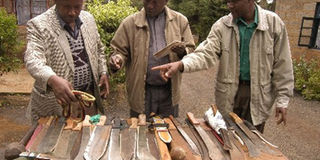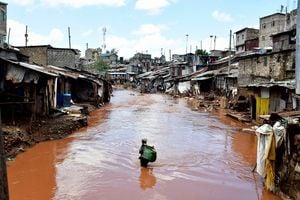How Mungiki killer squad plotted massacre

A display of weapons impounded by police on Monday evening, hours before 29 people were killed in Kiaruhiu and Gathaithi villages. Photo/ JOSEPH KANYI
The mass murder of 29 villagers, which has come to be known as the Mathira Massacre, was planned and executed in less than 12 hours, the Saturday Nation can reveal.
And it was strategically carried out by members of the outlawed Mungiki Sect whose intention was to avenge the killing of their members by vigilante gangs in the larger Kirinyaga District in Central Province, Kenya.
“We planned the attack hurriedly after we attended the burial of our colleague in Kiangumara village on Monday. The local people were very hostile to us and we realised that they had the intention of wiping out our people,” a member of the sect who spoke to our team in Karatina Town said.
Kiangumara village is at the boundary of Nyeri East District and Kirinyaga West District. It neighbours Gathaithi and Kiaruhiu villages where the massacre took place on Monday night.
The man who was being buried is among the 15 suspected Mungiki gang members eliminated by vigilantes in the greater Kirinyaga.
They were killed in cold blood by the vigilantes, who accused them of harassing traders and residents by demanding a “protection fee” and threatening them.
Hostilities against members of Mungiki have been building up in Kirinyaga, where the group has been trying to establish itself.
Same aggression
And the same aggression had started to spread to areas of Iria-ini Location in Nyeri East District, which borders Kirinyaga West.
The sect member said that as a result of the crackdown by the vigilantes, they had a lot of difficulties attending the burial of their colleague.
They could not even enter Kiangumara village while driving in vehicles or riding in motorcycle taxis (boda-bodas).
“We had to walk for several kilometres while disguising ourselves. And some of us had to keep away for fear that we would be attacked,” the terrified sect member said. He said they decided to retaliate to avert further killings, especially in Mathira.
Even before the burial had ended late in the afternoon, the Mungiki group had started mobilising their colleagues all over the larger Nyeri using their mobile phones. Their decision to attack Gathaithi and Kiaruhiu villages was well thought out.
They are next to Chehe Forest, which is part of the vast Mount Kenya Forest. And the area, which is mountainous, has ridges and valleys, which are covered with tea bushes.
As such, it was easy for the sect members to crawl through the tea bushes and hide in the forest, which is a few kilometres from one of the scenes of the mass murder.
“We trickled into the forest one by one. And we managed to do this with the assistance of some of our people on the ground,” the sect member explained.
It is from their hideout in the forest that the Mungiki group planned their attack.
Sensed danger
At the neighbouring villages of Gathaithi, Kiaruhiu, Kiangumara and Kiangobe villages, vigilantes had sensed danger. They crossed over into Mathira to seek reinforcement from locals.
Interviews with some of the local leaders and those who were in the vigilante squad suggest that some of the members of the squad had passed on the group’s watchword, Bantu, to the sect’s adherents hiding in the bushes.
And this suggests that it is possible that there were either Mungiki sympathisers in the villages or genuine members of the sect who communicated with the attackers.
This is because the attackers appear to have had prior knowledge of how the vigilantes were positioning themselves.
But the vigilantes, backed by the villagers, did not have an idea of the movement of the attackers.
And a section of the gang is said to have moved into one of the houses in the village as early as 6pm, where they lay in wait for darkness to descend.
Other attackers are said to have been hiding in the forest and tea bushes, waiting for instructions from their leaders, who were in the house.
The patrols by the vigilantes only started after the villagers went to sleep.
However, our Mungiki source could not reveal how they executed their plan, saying they are under oath not to disclose their strategies. But our investigations established that the Mungiki gangs started by burning the house in which they were hiding.
This was a strategy, one elder at Gathaithi village said, to light up the scene.
By then the vigilantes and the villagers had started their patrols in earnest and they all rushed to the scene apparently unaware that they were being ambushed.
This clearly suggests that the killers had positioned themselves strategically and that they knew some of their victims.
Most of those killed were hacked on the back of their heads, on the same spot that is said to bear a mark the sect members use to verify membership.
Some of the villagers were only armed with sticks due to the haste in which they were summoned.
A survivor also spoke of orders being given before the leader shouted “maliza! (finish them)” and the orgy of killings began. Those who fell down were the first to be killed.
From interviews with the owner of the home where a house was gutted and four workers killed, the Nation learnt that the house was torched in a bid to attract more villagers.




